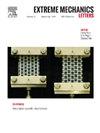与动脉瘤接触的磁性软导管的建模
IF 4.5
3区 工程技术
Q2 MATERIALS SCIENCE, MULTIDISCIPLINARY
引用次数: 0
摘要
磁性软导管(MSCs)代表了微创血管内手术中远程导航的突破,特别是在脑动脉瘤的线圈栓塞中。然而,目前的MSC模型在导航过程中往往忽略导管与动脉瘤边界之间的接触相互作用,这限制了它们在现实世界中的应用。为了解决这一问题,本文介绍了一个详细的理论模型,该模型考虑了MSCs的磁力学行为以及血管内环境中与动脉瘤的接触。研究了MSCs在不同形状的动脉瘤(如圆形、椭圆形和圆椭圆形)中的导航,以模拟临床实践中的各种解剖限制。我们提出了一个基于多项式近似和加权残差的数值框架来分析不同磁场下MSCs与动脉瘤接触时的挠度。参数分析进一步探讨了磁场强度、磁场方向、导管柔韧性和动脉瘤壁形状的影响,以便进行调整以确保安全导航。我们还研究了这些因素如何影响MSC导航不同动脉瘤形状的能力,为优化实际应用的设计策略提供见解。通过有限元模拟和实验验证了该模型的有效性,准确预测了血管内环境中MSCs与动脉瘤接触时的大变形。该结果为MSCs的安全导航提供了关键指导,从而降低了栓塞过程中错误放置线圈的风险,为MSCs在血管内手术中的临床应用奠定了坚实的基础。本文章由计算机程序翻译,如有差异,请以英文原文为准。
Modeling of magnetic soft catheters in contact with aneurysms
Magnetic soft catheters (MSCs) represent a breakthrough for remote navigation in minimally invasive endovascular procedures, especially in the coil embolization of cerebral aneurysms. However, current MSC models often neglect the contact interaction between the catheter and the aneurysm boundary during navigation, which limits their real-world use. To address this issue, this paper introduces a detailed theoretical model that considers the magneto-mechanical behavior of MSCs and the contact with aneurysms in endovascular environments. The navigation of MSCs through aneurysms of different shapes, such as circular, elliptic, and rounded-elliptic, is investigated to simulate the various anatomical constraints in clinical practice. We present a numerical framework based on polynomial approximations and weighted residuals to analyze the deflections of MSCs in contact with aneurysms under varying magnetic fields. A parametric analysis further explores the impact of magnetic field strength, magnetic field direction, catheter flexibility, and aneurysm wall shape, allowing adjustments to ensure safe navigation. We also examine how these factors affect MSC’s ability to navigate different aneurysm shapes, offering insights for optimizing design strategies for practical use. The proposed model is validated through finite element method (FEM) simulations and experiments, accurately predicting large deformations of MSCs in contact with aneurysms in endovascular environments. The results provide key guidelines for safely navigating MSCs, thus reducing the risk of incorrect coil placement during embolization and laying a solid foundation for the clinical application of MSCs in endovascular procedures.
求助全文
通过发布文献求助,成功后即可免费获取论文全文。
去求助
来源期刊

Extreme Mechanics Letters
Engineering-Mechanics of Materials
CiteScore
9.20
自引率
4.30%
发文量
179
审稿时长
45 days
期刊介绍:
Extreme Mechanics Letters (EML) enables rapid communication of research that highlights the role of mechanics in multi-disciplinary areas across materials science, physics, chemistry, biology, medicine and engineering. Emphasis is on the impact, depth and originality of new concepts, methods and observations at the forefront of applied sciences.
 求助内容:
求助内容: 应助结果提醒方式:
应助结果提醒方式:


